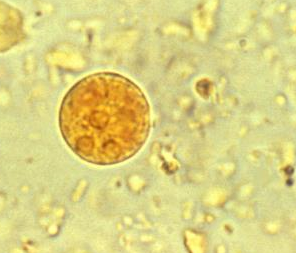WBR0406
Jump to navigation
Jump to search
| Author | [[PageAuthor::Yazan Daaboul, M.D. (Reviewed by Yazan Daaboul, M.D.)]] |
|---|---|
| Exam Type | ExamType::USMLE Step 1 |
| Main Category | MainCategory::Microbiology |
| Sub Category | SubCategory::Gastrointestinal |
| Prompt | [[Prompt::A 25-year-old man presents to the emergency department with abdominal pain and several episodes of bloody diarrhea. He recently arrived to the USA from an under-served town in Mexico. The patient undergoes GI endoscopy and is found to have multiple flask-shaped ulcers surrounded by a grey-colored base around the colonic mucosa. Stool analysis and examination reveal the following organism as shown in the image below. What is the optimal pharmacological therapy to eradicate the intestinal cysts associated with this patient's condition? |
| Answer A | AnswerA::Suramin and melarsoprol |
| Answer A Explanation | AnswerAExp::Suramin, melasoprol, and eflornithin are indicated for African sleeping sickness that is caused by ''Trypanosoma brucei'' and transmitted by Tse Tse fly bite |
| Answer B | AnswerB::Amphotericin B |
| Answer B Explanation | AnswerBExp::Amphotericin B is an antifungal agent that is helpful in treating systemic mycoses. |
| Answer C | AnswerC::Sulfadiazine and pyrimethamine |
| Answer C Explanation | AnswerCExp::Sulfadiazine and pyrimethamine are indicated for toxoplasmosis. |
| Answer D | AnswerD::Iodoquinol |
| Answer D Explanation | AnswerDExp::Iodoquinol, paromomycin, or diloxanide furoate is required for eradication of ''E. histolytica'' cysts. |
| Answer E | AnswerE::Metronidazole |
| Answer E Explanation | AnswerEExp::Metronidazole is the treatment of choice for ''E. histolytica''. However, metronidazole cannot eradicate the intestinal cysts, and patients require iodoquinol, paromomycin, or diloxanide furoate for cyst eradication. |
| Right Answer | RightAnswer::E |
| Explanation | [[Explanation::Entamoeba histolytica is a protozoan parasite that causes amebiasis, which is characterized by abdominal pain and bloody diarrhea (dysentery). E. histolytica infection is common in regions with poor sanitation. Human infection with E. histolytica occurs via ingestion of parasitic cysts, which are able to survive in food, water, and on land. The pathogenic trophozoite stage (mobile form) develops in the GI tract and exists only inside the host and in feces. The majority of individuals ingest cysts and remain asymptomatic; and only a minority of patients manifest with the clinical disease. E. histolytica infection causes characteristic colonic flask-shaped ulcers with grey-colored bases on colonoscopy (rupture of abscesses in the colonic submucosa). The disease may be further complicated by the development of amebic liver abscess that has an “anchovy paste” exudate. On iodine-stained microscopic analysis (picture above), the parasitic cyst measures 12 to 15 µm. Cysts are typically multinuclear with centrally-located karyosomes and peripheral chromatin. Treatment for E. histolytica dysentery is by metronidazole. Tinidazole may be an alternative for metronidazole but it is not used in the United States. Intestinal cyst eradication requires iodoquinol, paromomycin, or diloxanide furoate. Educational Objective: Entamoeba histolytica is a protozoan parasite that causes amebiasis, which is characterized by abdominal pain and bloody diarrhea (dysentery). It is common in regions with poor sanitation and causes typical flask-shaped ulcer in colonic mucosa. The first line treatment for E. histolytica dysentery is metronidazole. Addition of iodoquinol, paromomycin, or diloxanide furoate is required for cyst eradication. |
| Approved | Approved::No |
| Keyword | WBRKeyword::Microbiology, WBRKeyword::Entamoeba histolytica, WBRKeyword::Amebiasis, WBRKeyword::Protozoa, WBRKeyword::Parasite, WBRKeyword::Cyst, WBRKeyword::Iodoquinol, WBRKeyword::Abdominal pain, WBRKeyword::Bloody diarrhea, WBRKeyword::Diarrhea, WBRKeyword::Dysentery, WBRKeyword::Flask-shaped ulcer, WBRKeyword::Metronidazole, WBRKeyword::Pharmacological therapy, WBRKeyword::Treatment, WBRKeyword::Antimicrobial |
| Linked Question | Linked:: |
| Order in Linked Questions | LinkedOrder:: |
